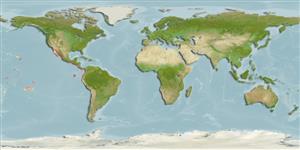Common names from other countries
>
Carangiformes (Jacks) >
Carangidae (Jacks and pompanos) > Scomberoidinae
Etymology: Oligoplites: Greek, oligos = small + Greek, hoplites = armed (Ref. 45335).
More on author: Günther.
Environment: milieu / climate zone / depth range / distribution range
Écologie
marin; saumâtre benthopélagique. Tropical; 32°N -
Eastern Pacific: Mexico to Peru.
Taille / Poids / Âge
Maturity: Lm ? range ? - ? cm
Max length : 56.0 cm FL mâle / non sexé; (Ref. 40637); common length : 30.0 cm FL mâle / non sexé; (Ref. 9283); poids max. publié: 1.6 kg (Ref. 40637)
Description synthétique
Clés d'identification | Morphologie | Morphométrie
Body elongate, fairly deep, and compressed (depth from 2.5 to 3.4 times in standard length); posterior edge of upper jaw extending beyond posterior rim of eye; upper jaw teeth small and villiform; lower branch of first gill arch with 8 to 13 gill rakers; scales small but visible, needle-shaped, embedded in the skin; body gray or brown; flanks and belly silvery with yellow highlights (Ref. 55763).
Adults inhabit coastal waters, entering estuaries (Ref. 9283). Dorsal and anal spines of this species are connected to venomous glands that may inflict painful wounds (Ref. 9283). Marketed fresh and salted or dried (Ref. 9283).
Life cycle and mating behavior
Maturities | Reproduction | Spawnings | Egg(s) | Fecundities | Larves
Smith-Vaniz, W.F., 1995. Carangidae. Jureles, pámpanos, cojinúas, zapateros, cocineros, casabes, macarelas, chicharros, jorobados, medregales, pez pilota. p. 940-986. In W. Fischer, F. Krupp, W. Schneider, C. Sommer, K.E. Carpenter and V. Niem (eds.) Guia FAO para Identification de Especies para lo Fines de la Pesca. Pacifico Centro-Oriental. 3 Vols. FAO, Rome. (Ref. 9283)
Statut dans la liste rouge de l'IUCN (Ref. 130435)
CITES (Ref. 128078)
Not Evaluated
Utilisations par l'homme
Pêcheries: commercial
Outils
Articles particuliers
Télécharger en XML
Sources Internet
Estimates based on models
Preferred temperature (Ref.
115969): 20 - 28.4, mean 24.9 (based on 70 cells).
Phylogenetic diversity index (Ref.
82804): PD
50 = 0.5312 [Uniqueness, from 0.5 = low to 2.0 = high].
Bayesian length-weight: a=0.00871 (0.00523 - 0.01450), b=2.96 (2.82 - 3.10), in cm Total Length, based on LWR estimates for this species & Genus-body shape (Ref.
93245).
Niveau trophique (Ref.
69278): 4.1 ±0.0 se; based on diet studies.
Résilience (Ref.
120179): Milieu, temps minimum de doublement de population : 1,4 à 4,4 années (Preliminary K or Fecundity.).
Fishing Vulnerability (Ref.
59153): Moderate vulnerability (45 of 100).
